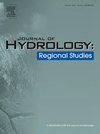Seasonal variability changes and trends in minimum discharge for Western Balkan rivers
IF 5
2区 地球科学
Q1 WATER RESOURCES
引用次数: 0
Abstract
Study region
This study focuses on the Western Balkans, specifically analyzing river basins across Bosnia and Herzegovina, Serbia, Montenegro, and North Macedonia.
Study focus
The objective is to investigate long-term trends in minimum river discharges from 1961 to 2020, with an emphasis on low-flow events and their seasonal dynamics. Minimum discharge magnitudes were categorized as M1 (lower) and M2 (higher) based on the 1961–1990 baseline period. Seasonal Mann–Kendall trend tests were applied to detect significant changes in low-flow frequency and intensity across a representative network of gauging stations.
New hydrological insights for the region
The results reveal a statistically significant increase in the frequency of M1 low-flow events during summer, indicating more severe low-flow conditions. This trend is especially prominent across central and southern stations. Winter season analyses also suggest rising minimum discharge values, albeit with spatial variability. Conversely, M2 events, indicative of relatively higher minimum flows, show a consistent and statistically significant decline across nearly all stations during summer. These opposing trends reflect a regional intensification of summer low-flow conditions and a possible shift in the seasonal flow regime. The findings underscore the growing vulnerability of Western Balkan river systems to hydrological droughts, likely driven by climate change and local watershed pressures. These insights hold practical relevance for water resource management, highlighting the urgency of adaptive strategies for drought mitigation and ecological flow preservation.
西巴尔干河流最小流量的季节变化和趋势
研究区域本研究重点关注西巴尔干地区,具体分析了波斯尼亚和黑塞哥维那、塞尔维亚、黑山和北马其顿的河流流域。研究重点:研究1961年至2020年河流最小流量的长期趋势,重点关注低流量事件及其季节性动态。根据1961-1990年基线期,最小排放量分为M1(较低)和M2(较高)。季节性Mann-Kendall趋势检验应用于检测具有代表性的监测站网络中低流量频率和强度的显著变化。结果表明,夏季M1低流事件的频率在统计上显著增加,表明低流条件更加严重。这一趋势在中部和南部车站尤为突出。冬季分析也表明,尽管存在空间差异,但最小排放值仍在上升。相反,M2事件表明相对较高的最小流量,在夏季几乎所有站点都显示出一致且统计上显著的下降。这些相反的趋势反映了夏季低流条件的区域强化和季节流态的可能转变。这些发现强调了西巴尔干河流系统越来越容易受到水文干旱的影响,这可能是由气候变化和当地流域压力造成的。这些见解对水资源管理具有实际意义,突出了缓解干旱和保护生态流量的适应性战略的紧迫性。
本文章由计算机程序翻译,如有差异,请以英文原文为准。
求助全文
约1分钟内获得全文
求助全文
来源期刊

Journal of Hydrology-Regional Studies
Earth and Planetary Sciences-Earth and Planetary Sciences (miscellaneous)
CiteScore
6.70
自引率
8.50%
发文量
284
审稿时长
60 days
期刊介绍:
Journal of Hydrology: Regional Studies publishes original research papers enhancing the science of hydrology and aiming at region-specific problems, past and future conditions, analysis, review and solutions. The journal particularly welcomes research papers that deliver new insights into region-specific hydrological processes and responses to changing conditions, as well as contributions that incorporate interdisciplinarity and translational science.
 求助内容:
求助内容: 应助结果提醒方式:
应助结果提醒方式:


